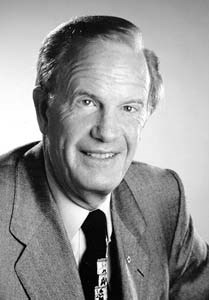Ted Rogers, chief executive officer of Rogers Communications Inc., the Canadian communications giant whose holdings include Sault Ste. Marie's Q-104 and EZ-Rock Radio, has died at age 75, CBC News is reporting this morning.
Rogers, one of the wealthiest men in Canada, had been in hospital since late October for an existing heart condition.
The following is the official corporate biography.
************************* Edward S. “Ted” Rogers Ted Rogers earned his Bachelor of Arts from the University of Toronto in 1956.
He was awarded an LL.B. in 1961 from Osgoode Hall Law School and was called to the bar of Ontario on April 13, 1962. In business, Mr. Rogers has always emphasized customer service and pioneering engineering and has been involved at the start-up stage with a number of ventures in broadcasting, cable television and communications.
Mr. Rogers specializes in identifying technologies that he can develop and popularize through technological innovation and marketing techniques. While Mr. Rogers was an articling student with Tory, Tory, DesLauriers & Binnington, he started Rogers Radio Broadcasting Limited, which acquired the nation’s pioneer FM station, CHFI-FM.
In 1962 he pioneered stereo broadcasting in FM with CHFI and also founded CFTR-AM in Toronto. By making available FM radios to boost FM penetration (then at three percent), Mr. Rogers was able to make more people aware of FM transmitters.
CHFI-FM quickly became one of Canada’s most listened to FM radio stations, becoming the most popular and profitable FM radio station in Canada.
Mr. Rogers’ interests in radio led him to cable television.
In the mid-1960’s Mr. Rogers wanted Canada’s fledgling cable operators to carry CHFI on a spare cable channel.
The more he studied cable, the more he became attracted to the potential for programming choices on cable, and decided to enter the cable business.
In 1967 he was awarded licenses for areas in and around Toronto, Brampton and Leamington. During the 1970’s, Rogers Cable TV became Canada’s most innovative cable company.
In 1974, it became the first cable company to expand past 12 channels, and the cable company specialized in adding more programming choice, in particular with multi-cultural television. Through a reverse-takeover in 1979, Mr. Rogers’ company, Rogers Cable TV Limited, acquired control of Canadian Cablesystems Limited.
In 1980, Rogers purchased Premier Communications Limited, which almost doubled Rogers’ cable subscribers and made Rogers the largest cable television company in Canada.
The legacies of Canadian Cablesystems and Premier Cablevision added enormously to those already in the company. Mr. Rogers then became a founding shareholder of Rogers Cantel Inc., which commenced service in 1985, to operate a national cellular telephone network in Canada in competition with the established telephone companies.
Rogers Cantel Mobile Communications Inc. (now called Rogers Wireless) is a public company, 51 percent of which is owned by Rogers Communications. During the years 1979 to 1982, Rogers Communications acquired and built a number of cable television systems in the United States.
In March 1989, Rogers Communications completed the sale of its U.S. cable television interests for CDN $1.581 billion. In September 1989, Rogers Communications Inc. acquired 40 percent of Unitel Communications, formerly CNCP Telecommunications.
In June 1992, Unitel was granted permission by the Canadian Radio-television and Telecommunications Commission to compete with the Canadian telephone monopolies in the long-distance market.
In January 1993, 20 percent of Unitel Communications was sold to AT&T.
As a result of this transaction, Rogers Communications Inc.’s interest in Unitel was reduced to 32 percent.
In September 1995, Unitel Communications reached an agreement in principle with AT&T and certain of its bankers to restructure Unitel.
At the close of this transaction, Rogers Communication no longer held an equity investment in Unitel. On March 31, 1994, Rogers Communications Inc. successfully completed its offer for the shares of Maclean Hunter Limited and on December 19, 1994, the CRTC approved the transaction.
The publishing assets of Maclean Hunter were subsequently combined with its existing radio and television operations to form Rogers Media Inc. In September 2000, Rogers Communications Inc. acquired the Toronto Blue Jays Baseball Club and several years later, in 2004, acquired Rogers Centre (formerly Skydome) which is the Blue Jays home venue and largest covered indoor entertainment complex in Canada.
In July 2001, Rogers Media acquired Sportsnet, and renamed Rogers Sportsnet that November.
The FAN 590 sports radio station joined Rogers Media in August 2001 along with 14 Northern Ontario radio stations. Rogers Cable continued the company's tradition of innovation with the launch of Digital Television in September 2001, providing Canada's most advanced digital network.
Rogers On Demand was launched as a home video library over cable in February 2002, and in November 2003, Rogers Cable makes personal video recorders (PVRs) available to its subscribers. In summer 2004, Rogers launched Rogers Yahoo!, a powerful Internet experience which combines Rogers' broadband Internet access with Yahoo!, one of the industry's leading providers of Internet content and services. In the fall of 2004, several strategic transactions were executed that significantly increased Rogers exposure to the potential of the Canadian wireless market.
Rogers acquired the 34 percent of Rogers Wireless owned by AT&T Wireless Services Inc, at an attractive price.
Soon thereafter, Rogers Wireless acquired Microcell Telecommunications Inc., along with its popular Fido brand, which created Canada's largest wireless operator and only GSM provider.
In December, Rogers Communications repurchased the shares of Rogers Wireless that were publicly held and proceeded to take the company private which significantly enhanced the company's operating & financial flexibility. Coinciding with the 20th anniversary of Rogers' launch of wireless services, on July 1, 2005, we introduced Rogers Home Phone voice-over-cable local telephony service in the Greater Toronto Area and also successfully completed the acquisition of Call-Net Enterprises Inc. (now Rogers Telecom Holdings Inc.), a national provider of voice and data communications services. ************************* Earlier SoooToday.com coverage
